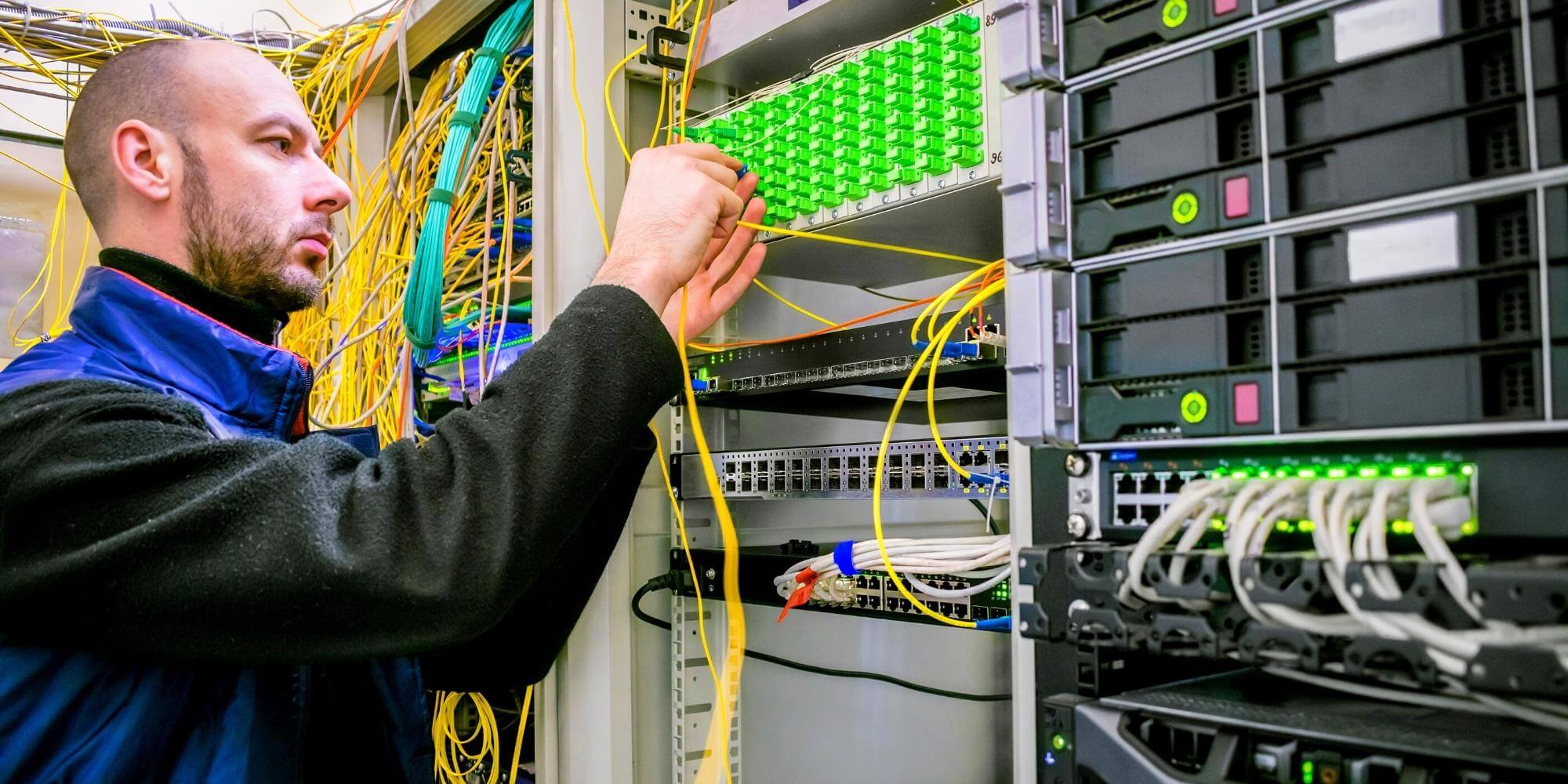
Information technology staff have a continually expanding number of options to evaluate when considering how to network end-users at branch offices, head offices or regional primary sites with business applications that are hosted in private data centers or in the cloud. Choosing wireline vs wireless options can pose a challenge for even an experienced IT team.
In this post, we’ll review wireline vs wireless options and help inform your decisions to ensure you find the network connectivity option that’s right for you. We’ll start by breaking down both options at a high level, and going through the pros and cons of each.
What are Wireless Connection Options?
Mobile Wireless
Mobile wireless — provided by telecommunications or cable companies in your area, typically 2G, 3G, LTE, 4G and now 5G — are the first broadly available option for your business. The availability of some of these technologies may vary, depending where you are in the world. These connections offer data throughput that can range from under 1Mbps to nearly 1Gbps.
2G
GPRS: 50 Kbps
Edge+: 1.3 Mbps
Uses include:
Voice
SMS text messages
SMS picture messages
MMS messages (pictures, video
3G
2Mbps
Uses include:
Voice
SMS picture messages
MMS data (video calling, mobile internet)
4G/LTE
Theoretical max: 300Mbps
Actual performance: ~100Mbps
Uses include:
Voice
SMS text messages
SMS picture messages
MMS messages (pictures, video
5G
Theoretical max: 10 Gbps
Actual performance: ~1Gbps
Uses include:
Gaming
Streaming video
IoT device control
Autonomous devices
Telecom or cable carriers that offer wireless connectivity often bundle mobile wireless into their business wireline services as a backup or redundancy option.
Pro Tip: When evaluating bundles, businesses should consider if a single-vendor solution with multiple technologies (broadband + wireless or fiber + wireless) is better than a multi-vendor solution, where one carrier delivers the broadband or fiber and another provides the wireless.
A multi-vendor solution offers greater potential reliability and survivability, as there is less chance of both core networks failing at the same time.
5G Networks for Business
The hype surrounding 5G and the promotion of the bandwidth, flexibility, portability and new business models it can facilitate often make 5G seem like the best choice for every instance.
But in many regions, coverage of newer, higher-bandwidth mobile wireless tech (4G or 5G) may be limited to metropolitan areas or high-density neighborhoods. Suburban or industrial areas may not see upgrades to the latest wireless tech as quickly. And while 5G is capable of offering very high speed connections, some carriers roll out 5G service with bandwidth limitations to save money on back-end networks.
A further challenge associated with 5G is that carriers must increase radio or antenna density in the network to achieve maximum throughput — which means they need to secure locations for this additional infrastructure and deploy the appropriate networking capacity.
Finally, real-word 5G deployments have demonstrated that practically achievable speeds are lower than the theoretical rates often advertised.

A Rootmetrics study conducted in the US during the second half of 2020 demonstrates how carriers concentrate 5G launches in different cities and markets.
AT&T registered strong 5G median download speeds of 60Mbps or better in 18 markets, with the fastest coming in at 94.8Mbps in Kansas City, Mo.
Most T-Mobile 5G median download speeds closely matched its 4G LTE speeds, but it did deliver 60Mbps or more in 5 markets, with a top speed for 88Mbps in Fayetteville, N.C.
Verizon’s fastest 5G median download speed hit 223.1Mbps in Houston (with 0.3% 5G availability), while its fastest low-band 5G median download speed was 68.9Mbps in Washington, D.C. (42.8% availability)
The uneven, spotty nature of each carrier’s 5G rollouts is related to the radio spectrum they have access to. The below Rootmetrics chart details each carrier’s options and reveals the challenges that exist in deploying a consistent 5G experience across an entire country.
Low-Band <1GHz
Travels far and penetrates deep indoors. Can reach rural communities. Works with 5G and 4G LTE. Biggest disadvantages: slowest speeds of all spectrum types.
Mid-Band 1-6 GHz
Known as the “sweet spot” for 5G connectivity. Offers fast speeds plus broad geographical coverage. Works with 5G and 4G LTE. Biggest disadvantage: difficult for carries to acquire.
High-Band (mmWave)
Incredibly fast speeds and hotspots of 5G connectivity. Faster than other bands. Works with 5G only. Biggest disadvantage: travels a very short distance.
In conclusion, while 5G will clearly play a role in your networking decisions going forward, it’s wise to remember that its use may be limited by geographic availability.
Fixed Wireless
The main alternative to carrier mobile wireless for business is wireless options like WiMax, which is a technology used by Wireless Internet Service Providers (WISP). WiMax is part of the 802.16 standard — which likely also includes the home or work WiFi you use today.
Wireless Internet Service Providers are largely local or regional operators focused on filling gaps in network coverage for business and residential customers alike. WISPs use creative solutions to offer high-bandwidth connections to businesses, warehouses, truck yards, industrial sites, homes or other facilities that lie outside wireline technologies’ coverage or bandwidth. They can offer bundled services in addition to wireless access solutions, including hosted business services, data backup, disaster recovery, voice services and data center or cloud services. Each WISP has developed their own service stack aimed at complementing their network technologies.
Speeds offered by WISPs can range from 1Mbps to multiple Gbps, depending on equipment used and core network and internet gateway capabilities. Fixed wireless is a point-to-point technology (meaning antennas need a clear line of sight to other antennas, so consider the placement of antennas on your building or facility when looking at fixed wireless options.
Pro Tip: It’s not always necessary to purchase the highest possible fixed wireless speed. The decision regarding how much to spend on raw speed should be based on specific application requirements and use-case (number of users, simultaneous sessions, quality of service) you aim to realize.
Benefits of Wireline vs Wireless for Business
Wireless technologies offer a wide range of benefits when considering connectivity for your business:
- Ease and flexibility, no need to worry about in-building cabling
- Ability to get up and running quickly — ideal for pop-up or mobile businesses
- Fast turnup and operations for opening new facilities
- Combined with SD-WAN, can offer rapid deployment and high reliability
What is Wireline Network?
Wireline technologies tend to be viewed as more reliable than wireless, but broadband technologies like xDSL and DOCSIS cable rely on radio frequency transmission over copper instead of air, meaning they can suffer from signal attenuation, loss and interference — just like wireless.
The physical infrastructure used to deliver broadband services (which, in many parts of the world, are not just best-efforts internet but can also include MPLS) also has single points of failure:
- Broadband models in nodes, central offices/POPs
- Junction boxes
- Splice points
- Overhead utility poles
- Underground conduits
Broadband services also need to contend with data network switch failures, power outages and network congestion caused by over-subscription. An xDSL circuit might only be 1 to 2 kilometers from a Central Office when mapped in a straight line, but that distance can more than double due to cable routing, resulting in poor performance.

Are Fiber Networks Better?
Fiber doesn’t suffer from the same challenges as broadband, but it does present other issues:
- Fiber cuts can occur with regularity
- Flooding can damage fiber equipment in underground conduit and manholes
- Cheap small-form factor pluggable (SFP) connectors can fail (if used)
Fiber does offer the ultimate high-speed internet solution, but deployment is not inexpensive. (Fiber deployment is expensive on its own (~$100,000/trenched mile, depending on geography.) Permitting and building management ownership challenges are also not inconsequential.
Whatever the cost, building fiber is clearly expensive — a factor that explains the slow rollout of fiber services in rural areas (and less to populated areas close to major urban centers).
Good to Know: Some cities have tried to counter this cost by building their own fiber networks and reselling access to ISPs and telecoms, a method aimed at stimulating local economies by providing infrastructure to attract internet and tech companies.
Wireline vs. Wireless: Policies and Permits
Even with the best wireline technologies, regulatory policies generally have a massive impact on pricing and packages. As many competitive ISPs have discovered, deploying networks can require working with incumbent network providers, and wholesale network purchases don’t provide the massive margins required to offer competitive prices to business customers. Offering price changes hinges on convincing both government regulators and lobbying incumbents — not an easy task.
The challenges associated with securing fiber in your facilities can further complicate things. Adding fiber in your building can require dealing with building management (unless you own the property) and getting access to risers and data closets, as well as drilling through walls or negotiating with existing conduit owners and securing local permits to bring fiber into your facilities.

Use Wireless and Wireline Together with SD-WAN
Instead of trying to balance wireline vs wireless, your best option may be to use wireless and wireline solutions from different carriers and network providers. The ability to combine these varied methods is a key benefit of software-defined wide area networking (SD-WAN).
Using SD-WAN allows your business to combine the bandwidth of multiple connections from different providers into a single network, achieving higher uptime by reducing reliance on a single provider or network. Using both wireless and wireless providers can ensure your company achieves the same uptime and reliability, since the network can use either or both wired and wireless transmission or failover from wireline to wireless connections for an ideal combination.
SD-WAN services are available from telecoms, ISPs, voice providers and companies that offer hosting or managed services. SD-WAN can replace more expensive forms of wireline connectivity for many organizations with multiple internet connections. In fact, Gartner predicts that by 2025, 40% of enterprise locations will rely solely on WAN connectivity to deliver flexible, cost-effective, scalable bandwidth (as opposed to 15% in 2021) and that 65% of enterprises will have implemented SD-WAN (compared with around 40% in 2021) to enhance agility and support for cloud applications.
Beyond the benefits that SD-WAN platforms provide related to bandwidth and cost, SD-WAN platform can also enhance the end-user experience by giving businesses control over network performance, letting them prioritize voice and video calls in Quality of Service settings to offer better meeting experiences and outcomes.
And even if you only have one or two connectivity options for your business, layering SD-WAN can provide failover from wireline to wireless and help you maximize performance. But the biggest benefits of SD-WAN, from a business perspective, is the simplicity and management capabilities it offers. SD-WAN can simplify the network-building process for businesses with multiple locations, and allows organizations trying to build a network solution from multiple providers to use any available connections, regardless of underlying provider and technology.
The flexibility of SD-WAN empowers competitive service providers, managed service providers and cloud providers to access the network business in a simple way, allowing these providers to offer best-of-breed networking alternatives to those sold by incumbent and traditional carriers while simultaneously making it simpler for consumers to use their services.
Want to learn more about how SD-WAN can simplify the decision of wireline vs. wireless connectivity? Talk to the team at Turnium today.
